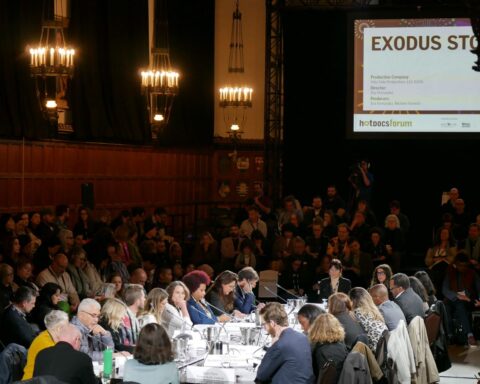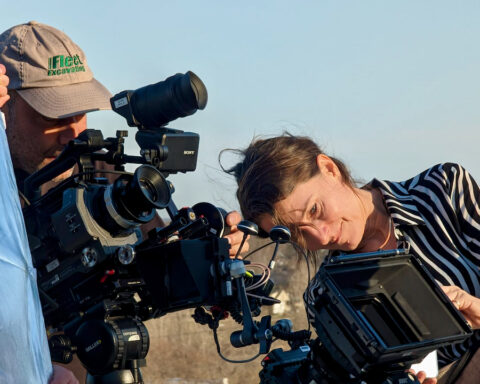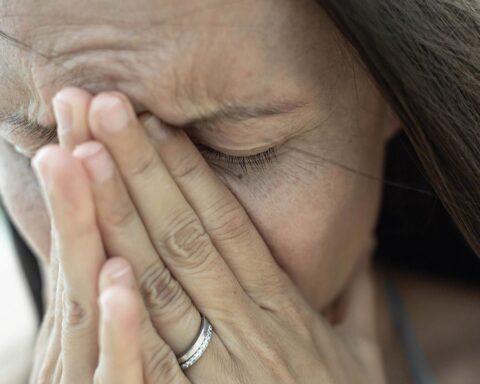I arrive at Sunny Side of the Doc with a pertinent brief but am instantly distracted by the allure of the venue. La Rochelle, France, may be a bit complicated to get to, but it is a divinely manageable French port city with outdoor cafés, seafood restos and excellent flat bike trails that meander along the ocean past beaches, dunes and wildflowers. Most temptingly of all, Sunny Side offers a bank of free bikes that seem to float without pedalling through the sea-kissed air.
My brief is to plumb this international documentary film market for information about international co-production in these timorous times. Sunny Side is a good place to think about international co-production of the auteur, one-off documentary, whether from Europe, Latin America or Asia. It is one of the few content-filmmaker-respectful markets, infused with the vision of Yves Jeanneau, ex-filmmaker, producer, now general commissioner of Sunny Side of the Doc and Asian and Latin Side of the Doc, and, incidentally, a PhD in Philosophy who studied under Michel Foucault.
In a pre-market editorial, sent to participants and the press, Jeanneau shared his thoughts on trends and developments in the documentary market. He said that a turnaround toward more intelligent content was beginning to appear, but was still weak due to the timidity of the public, western, traditional markets. The evolution he noted was that companies such as BBC and ITV (now opening offices in France) as well as more commercial channels were looking for less trashy formats. He noticed that companies throughout Europe were scouting documentary-trained people who could shoot and edit clever, engaging films that would enhance content and characterizations. In his editorial, he wrote:
“It is also the capacity provided by the documentary language which interests them: the closeness to characters/construction/contradiction/evolution/belonging to a history and a place…in short, a humanity and a better ‘reality effect.’”
The trends Jeanneau highlighted were:
1. A move toward ‘entertainment’ with the possibilities provided by cross-media strengthening qualitative diversification. He said it is still a time of research and development in Europe, not yet a full sector, but the NFB in Canada has developed interactive programming, and ARTE and the NFB are working together on a transmedia project. As he wrote:
Like in Canada, it will be impossible tomorrow to propose a film project without developing a transmedia strategy. Major projects have just been launched, in the U.S. and Canada in particular, often financed by foundations or institutions—and not by broadcasters—which are first and foremost transmedia projects, and secondly films…. This reversal of the situation is difficult for European producers to understand and accept.
Jeanneau viewed this cross-fertilization as an opportunity to put documentaries at the heart of new writing, new distribution methods, new uses and the mobilization of special interest groups. He felt this harked back to the roots of documentary as social-intervention films, “creating interaction, giving an understanding of what is real, escaping from official, ‘corporate’, information. The freedom of speech provided by these new media does not seem to have been used very much until now.”
2. The emergence of the educational. In his travels around the globe, Jeanneau has seen strong educational initiatives in Asia and Latin America funded by foundations such as BaKaFORUM in Switzerland, and by religious and educational institutions. Not today, he says, but tomorrow, Africa will use TV for basic educational purposes. He points to the network of 40 small local educational channels in Latin America such as Jalisco TV in Mexico, whose main role is to provide their audience with basic information—about post-natal childcare, electricity-covering a how-to, functional gambit. For Jeanneau, Knowledge Network in Canada, under Rudy Buttignol’s committed, knowledgeable leadership, is a world model for the evolution of educational TV. As Jeanneau wrote,
In all Latin American and African countries, and a number of Asian ones, which are just beginning to have broadband Internet or television cover, needs are clearly expressed in terms of information/education. And they recognize this value in documentaries, a fact we tend to forget in Europe.
Examples from the U.K. and Japan are edifying (Teachers’ TV, the Open University, NHK Educational, etc.). The ‘Specialist Factual’ (Science, History…) is strengthening, and its storytelling is very creative. But ‘small producers’ have great difficulty in gaining access to ‘large broadcasters’ who develop their own co-productions. Average production budgets are very high (around €700 K)…But it is an area, which is favourable to co-productions and brings in the highest documentary audiences, and often-good DVD releases along with good participation on dedicated sites… Producers need support—i.e., orders—from their national broadcasters to be able to go out and find international partners.
3. Documentaries made for cinema, which he said “exploded” this year.
“The worldwide success of Océans, Babies —very mainstream—or films such as Wasteland, Inside Job, and not forgetting Pina…and French films such as Le Président, which had 75,000 entries in France, or Les Yeux Rouges in Chile, which attracted more than 10 percent of the population!…suggest that television will have to reconsider its faintheartedness.
It should be added that these films also sometimes have ‘new’ forms of financing, via foundations, crowd funding, parallel (and not secondary) exploitation in VOD and DVD.”
Jeanneau noted that humour is still rare in the documentary world and concluded that “[t]he opening of new territories, the digitizing of media, the globalization of political, social or environmental issues, the economic difficulties each broadcaster is facing…are all arguments and assets which should encourage all the players in the sector to ‘think international.’”
I catch Jeanneau in an aisle of the exhibition centre and ask him whom I should interview for the article. He suggests Richard Bradley, Lion TV and Chang Chaowei, SUNTV, “the man with the hat.” I make a beeline for the man with the hat, who happily greets the approaching journalist but doesn’t speak English and doesn’t look Chinese. His producer Bruno Bettani offers to interpret and I discover that I am exchanging smiles with Lucho Alarcon, a Chilean who has just launched Terra Incognita to broadcasters at the morning BIP (Best International Projects Showcase) and is therefore not as surprised as I that I am talking to him. What to do? I usher Bettani inside, thinking I can see what this market can do for small independent producers.
In an interview he records on his iPhone and mails to me that day, he says he was grateful to be selected for the BIP pitch. He had seven minutes to present and seven minutes for questions and already had a Dutch co-producer (they met in a bar at IDFA in Amsterdam) and a Japanese partner (from the speed-dating networking at Cannes) and came to find buyers. Four broadcasters have expressed interest in the documentary. On a helpful tip, he says he moved fast after the pitch and met interested broadcasters immediately, in order to capitalize on the post-pitch moment.
Well, that was interesting if unexpected, I think, as I stroll through the aisles looking for the real Chang Chaowei. This 22nd Sunny Side market is billed as ‘Special Asia’, a hot, new area that Jeanneau has been cultivating (along with Latin America) to offer relief from the Anglo-Saxon, American focus of many international film markets. It has 1,743 participants, 290 international commissioning editors and buyers, 455 exhibiting companies and 63 countries, including a fascinating contingent of neophyte Asian and Latin American participants offering their wares and co- production charms to an international market.
I reenter the exhibition area looking for Richard Bradley, whom I will never meet, and am drawn to an Under-30s Talent afternoon BIP pitching session. The thing that strikes me most about this twice-daily aspect of the market is that there are seven captive commissioning editors in a seemingly friendly, helpful mood with actual pre-buy money to invest. Perhaps it’s my innate optimism or naïveté but I experience a frisson of “counter-doldrums.” There they are from ITVS, arte, NRK Norwegian Broadcasting Corporation, A&E US, Al Jazeera Witness, TVF International and Link TV. The editors give their mostly encouraging comments, transcribed later for participants, and I leave thinking this is better than a kick in the ass.
Chang Chaowei is wearing a baseball cap when I finally sit down with him. He’s just pitched Surfacing at 175: Aftermath of the Three Gorges at a BIP session. It was the first time SUNTV presented internationally and they will go on to win 2,000 euros for this year’s best science and history project. Jeanneau thinks a key element in the success of the pitch was ‘surprise.’ For most people, the existence of independent Chinese investigative films is new, as it was for him when he recently met his first independent Chinese producers. “It’s a change, a real discovery; it’s hope,” he says. “These people aren’t officials, they’re real people, documentary makers like you and I.” Jeanneau is sure someone is making a film about the crash of the government’s new super-high-speed train and “[t]hat couldn’t have been the case a year ago.”
Chang, meanwhile, is discussing a possible Chinese co-production project with a foreign producer, trying to find common ground between a preset outside perspective and recent changes which make the issue more complex from an internal POV. Chang is a new player, one of the new breed of Chinese filmmakers and producers entering the international market and quickly learning how to keep what’s integral and reshape and restructure for international exposure. So far, this market has given Chang Canadian, French and British co-production interest for his Three Gorges film and a buy from Danish TV. “It’s an international issue. We want to work with others,” he says. And as Jeanneau tells me later, “There are 350 million people in China. It’s a real market. It will not be easy to work with the Chinese, but it was not easy to work with the Americans or British either. It is a possible way to go.”
In a nearby stand, I meet Chen Erfan of Rare, the largest independent production company in China, which is actively looking to co-produce. Chen tells me his company can assist in China with cultural sensitivity, send people out of China to shoot and offer access to Chinese broadcasters. He says China has 200 channels and claims a relationship with 60 of them. Rare’s entry into the international arena, first Sunny Side Asia, now La Rochelle, is because after 10 mediocre years for documentary in China, the government’s policy has become very positive toward the doc industry. In the next five to 10 years, the market in and out of China will grow quickly, thanks to the government’s strong incentives for documentary companies and TV networks. Independent producers such as Rare, SUNTV and CINEX feel their documentaries are now able to offer a view of China that is more independent and less tied to serving the country as propaganda than ever before. It seems a magic moment for Chinese doc and co-production.
I am walking by the experts’ free-advice area, thinking that although everyone says there are too many films for a shrinking market, somehow that vibe seems non-operative here and now. I’m thinking that we need public broadcasters to champion documentary and how many people in the hall I’d like to speak to when I spot Films Transit international sales agent Jan Rofekamp among the experts, holding court. I wait my turn, ask him about good and bad markets and take notes as he distills years of market experience into etched advice. Rofekamp says:
Go to a market place with:
• Broadcast buyers
• Non-broadcast funders
• International co-producers
• A convivial atmosphere
To play the market:
• Get a list of delegates
• Prepare who you want to see
• Make appointments
• Be ready to answer the buyer’s question: Why should I bring this to my audience?
“Sunny Side is good for co-production,” Rofekamp adds. “There are many producers, the event is not crammed into a short time as in other places and it’s a nice environment.” These kudos echo the words of NHK producer Sayumi Horie, whom I later overhear talking to a young Korean director. At MIP, she says, producers have to present a completed idea; there is no time to discuss, whereas at Sunny Side there is time to talk about ideas. “Of course, the idea must be very international or no one will pay,” she cautions.
On the last day, I find Jeanneau again. He has brought together filmmakers, producers and broadcasters from around the world and embraced the newly emerging producers of Asia and Latin America. He wants us to know that “the Anglo-Saxon world is not at the centre of the world.” That the BIP showcase featured at Sunny Side is very encouraging to young companies. That it is a critical moment to tell the truth of China internationally. That what we all need for documentary quality is to give new talent the opportunity to test their talent and grow.
His caveat is that the commissioning editors, the so-called ‘decision-makers,’ are less and less able to make decisions. Money in western public television is dwindling, competition for viewers is much tougher and documentary is not the optimum response when fighting for ratings. ‘Documentary’ has become an anachronistic word in the West. Instead it’s called ‘factual entertainment’ or ‘factual specials,’ and broadcasters are not looking for documentaries but for series or formats. As much as an editor may like a show, it’s difficult for him or her to take a one-off from the market. Increasingly, to minimize risk and keep editorial control, broadcast organizations are trying to centralize. Rather than work with one man or woman, they prefer large familiar companies and programme agreements for hundreds of hours. “After 22 years of Sunny Side, I feel I’m at the starting point,” Jeanneau says. “Still fighting for something that is insecure, that can disappear at anytime. The new Chinese and Asian producers are important because it gives hope.”
It’s still sunny outside Sunny Side. I see Chang contemplating the bikes as I leave the very nice ambience of the market and ride off into an even nicer one.
Next year, Sunny Side in La Rochelle will be held from June 26 to 29, Latin Side of the Doc will be in Buenos Aires, Dec. 6 to 8, and Asian Side of the Doc in Singapore in March. To submit to the BIP pitching session, consult sunnysideofthedoc.com. Don’t forget the bikes











